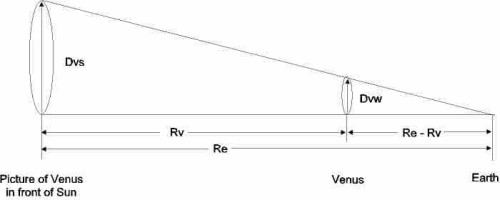 Deutsch Deutsch |
Determination of Venusdiameter |
| Determination of the Venus diameter In the photo, which was taken at 12:44 o'clock, I measured the diameter of the Venus disk Dv = 5 mm and the diameter of the sun picture Ds = 165 mm. That means it that you could pack the Venus 33-times into the sun diameter. In order to achieve from the dimensions in the picture to the sizes in the reality, the diameter ratio must be multiplied by the genuine diameter of Sun ds = 1,424*109m, which I concluded from the observations of Mercury. That results in a Venus diameter of: (3): Dvs = ds * Dv/Ds = 43,152 km ! This value equals to the 3.4-times-diameter of Earth and is obviously wrong, if you consider that Venus and Earth are similar in size. Here we are subject to a genuine error in reasoning: While concluding the real size of the celestial bodies from the picture, we did not consider the depth. Far objects, like the sun, appear to us smaller than the closer Venus. Since it covers a part of the sun during the transit, you set the black Venus disk into the same level as the sun surface intuitively, whereby it appears too large from your observation position in the reversal conclusion. What you observe, is called the apparent diameter Dvs of the Venus. Fig. 23 describes this context.  Fig. 23: Apparent diameter of the Venus From the application of the 'theorem on intersecting lines' the true diameter results in (4):   Ds = diameter of the sun picture Dv = diameter of the Venus picture ds = true diameter of Sun Dvs = apparent diameter of Venus Dvw = true diameter of Venus Re = orbit of earth Rv = orbit of Venus In order to compute the diameter of Venus, you need additionally the orbit data of Venus Rv and Earth Re (4). Thus a new task was defined: Is it possible to determine from my photos the orbit of Venus? Unfortunately this task is solvable only with additional effort in mathematics. Read on with orbit data evaluation of Venus Back to transit of Venus |
|
| Copyright by Hans Joachim Ilgen since 1950 | |